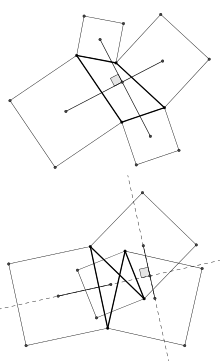Van Aubel's theorem

The theorem can be applied to a complex (self-intersecting) quadrilateral.
In plane geometry, Van Aubel's theorem describes a relationship between squares constructed on the sides of a quadrilateral. Starting with a given quadrilateral (a polygon having four sides), construct a square on each side. Van Aubel's theorem states that the two line segments between the centers of opposite squares are of equal lengths and are at right angles to one another. Another way of saying the same thing is that the center points of the four squares form the vertices of an equidiagonal orthodiagonal quadrilateral. The theorem is named after H. H. van Aubel, who published it in 1878.[1]
See also
Notes
- ↑ van Aubel, H. H. (1878), "Note concernant les centres de carrés construits sur les côtés d'un polygon quelconque", Nouvelle Correspondance Mathématique (In French)
|format=requires|url=(help), 4: 40–44 .
External links
| Wikimedia Commons has media related to Van Aubel's theorem. |
- Weisstein, Eric W. "van Aubel's Theorem". MathWorld.
- Van Aubel's Theorem for Quadrilaterals and Van Aubel's Theorem for Triangles by Jay Warendorff, The Wolfram Demonstrations Project.
- The Beautiful Geometric Theorem of Van Aubel by Yutaka Nishiyama, International Journal of Pure and Applied Mathematics.
- Interactive applet by Tim Brzezinski showing Van Aubel's Theorem made using GeoGebra.
This article is issued from
Wikipedia.
The text is licensed under Creative Commons - Attribution - Sharealike.
Additional terms may apply for the media files.